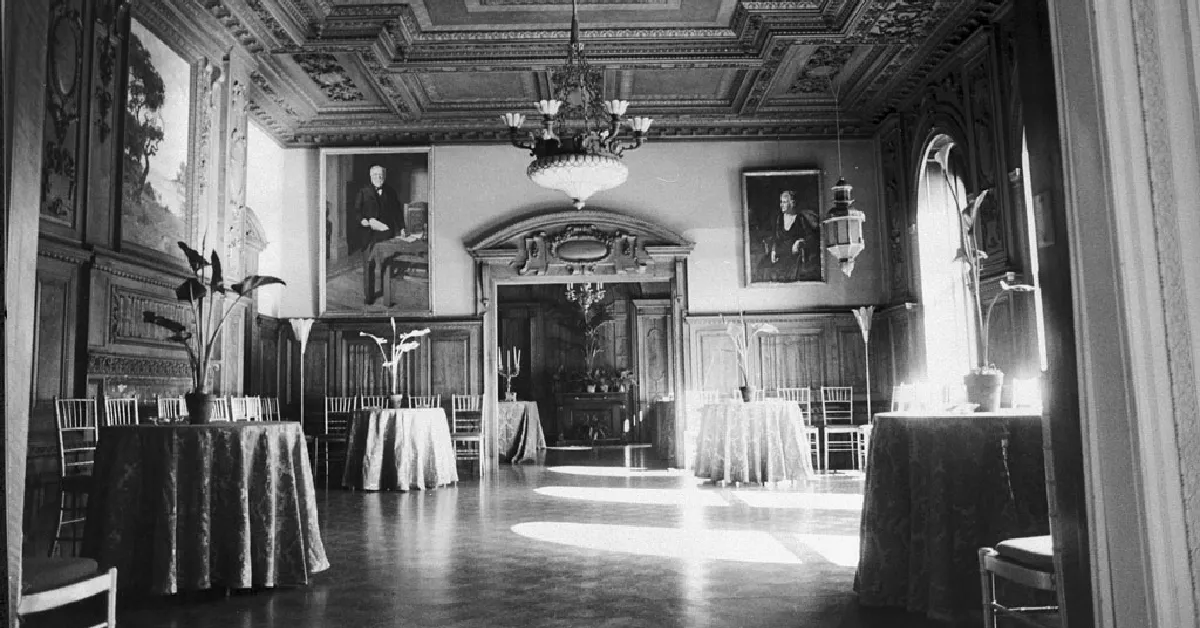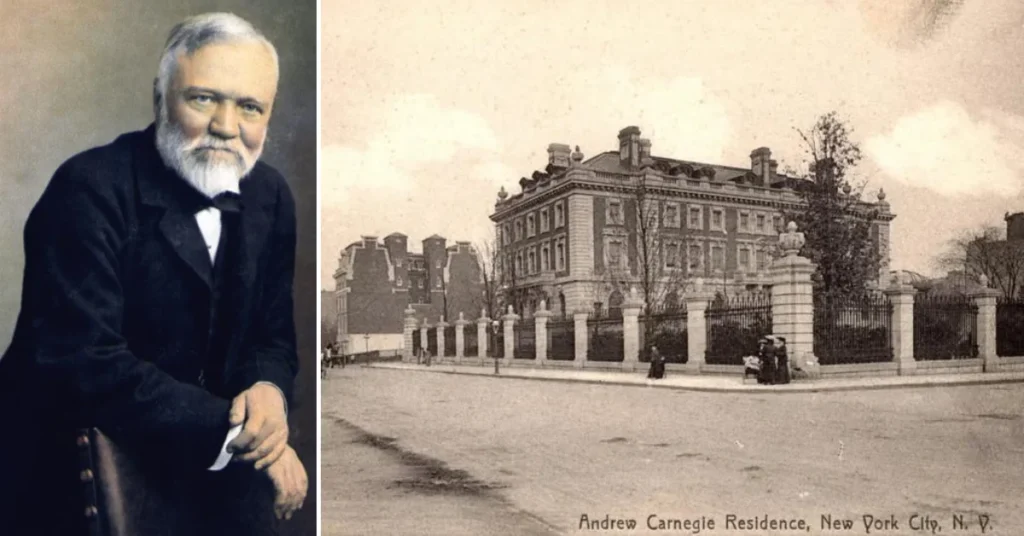The Andrew Carnegie House stands as one of New York City’s most remarkable historic house museums. Built from 1898 to 1902, this 64-room residential mansion at 2 East 91st Street now serves as the Cooper Hewitt Museum, America’s only design museum. The steel industrialist’s residence showcases Georgian Revival architecture and houses the Smithsonian Institution’s premier design collection within this Manhattan estate.
Andrew Carnegie House
The Andrew Carnegie House represents a pinnacle of Gilded Age architecture and American industrial wealth. The mansion contains at least 64 rooms across three basements and four above-ground stories, designed by the architectural firm of Babb, Cook & Willard in the solidly comfortable style of an English Georgian country house. This Carnegie family home stands as both a palatial residence and an architectural landmark.
When Carnegie purchased the land for the house in 1898, he purposely bought property far north of where his peers were living. This strategic decision transformed the Upper East Side into what became known as Carnegie Hill. The mansion’s construction cost approximately $1.5 million in 1902, equivalent to over $50 million today. Carnegie lived in the house with his wife Louise and daughter Margaret until his death in 1919, making it a true family dwelling that contrasts sharply with the modest tenement buildings that housed New York’s working class.
Location and Architecture of the Carnegie Mansion
The Carnegie Mansion occupies a prime location on Fifth Avenue, directly across from Central Park. This private residence turned museum was groundbreaking in its location, far from what was then fashionable New York; as a catalyst for development, giving rise to the neighborhood known as Carnegie Hill; and in its design, with its modern steel-frame construction and its spacious landscaped garden.
The mansion, designed in the Georgian style with Beaux Arts accents, showcases neoclassical elements and ornate detailing that reflect English country house traditions. The building features limestone facades, Georgian Revival details, and elegant proportions. The terrace and garden are located on the southern half of the property, which is enclosed by an elaborate cast iron fence with granite knee wall and piers capped with stylized acorns and urns, mirroring the detailing of the Carnegie dwelling.
Building the 64-Room Mansion
The construction of the mansion showcased cutting-edge technology for its time. The Carnegie homestead was built with numerous mechanical features, including dedicated heating and cooling systems, a steel superstructure, and elevators. This made it one of the first luxury houses in New York to feature such advanced systems.
The mansion had 64 rooms on five floors, the top of which was for servants’ quarters. There were multiple libraries, parlors, sitting rooms, bedrooms, halls, pantries, and skylights throughout the dwelling. The industrialist spared no expense in creating a home that balanced comfort with technological innovation. The steel frame construction, revolutionary for residential buildings at the time, allowed for larger interior spaces and better structural integrity. The mansion also featured multiple elevators, advanced plumbing systems, and electric lighting throughout every room and hallway.
Carnegie Family Life at 2 East 91st Street
The Carnegie family transformed the mansion into a center of intellectual and social activity. The family library on the second floor served as Carnegie’s private study where he conducted business and planned his charitable activities. Louise Carnegie managed the household operations and entertained guests from around the world at this Fifth Avenue home.
The mansion’s Museum Mile location made it a gathering place for artists, writers, and intellectuals. Carnegie’s daughter Margaret grew up in the house, enjoying the luxury of having her suite of rooms and access to the mansion’s extensive gardens. The family employed numerous staff members who lived in the dedicated servants’ quarters on the top floor. The mansion’s multiple parlors and reception rooms regularly hosted dinners and social gatherings that brought together prominent figures from business, politics, and the arts within this upper-class household.
Transformation into the Cooper Hewitt Design Museum
After Carnegie died in 1919, the mansion underwent several ownership changes before becoming a museum. Founded in 1897 by three granddaughters of industrialist Peter Cooper, the Cooper Hewitt Museum was originally under the umbrella of the Cooper Institute. The Cooper Hewitt Museum now resides in the historic Carnegie Mansion, which was constructed for industrialist Andrew Carnegie from 1898 to 1902.
Cooper Hewitt, Smithsonian Design Museum is a design museum at the Andrew Carnegie House in Manhattan, New York City, along the Upper East Side’s Museum Mile. It is one of 19 Smithsonian Institution museums and one of three Smithsonian facilities located in New York City. The transformation preserved many original architectural features while adapting the space for museum use. Original rooms like the oak-paneled library and formal dining room remain intact, allowing visitors to experience the mansion’s original grandeur as both a historic house and a museum building.
Visiting the Andrew Carnegie Mansion Today

The Cooper Hewitt Museum welcomes visitors to explore both the mansion’s history and contemporary design exhibitions. The Cooper Hewitt museum is open 10 a.m. to 6 p.m. daily, closed Thanksgiving and December 25. General admission costs $22 for adults, $16 for seniors (62 & above), $10 for students and visitors with disabilities, and is free for visitors 18 & under.
Pay What You Wish admission is available from 5 to 6 p.m. daily. The museum currently features “Acquired! Shaping the National Design Collection”, showcasing the museum’s permanent collection. Upcoming exhibitions include “Made in America: The Industrial Photography of Christopher Payne,” opening November 21, 2025, through Spring 2026. The museum shop offers design-focused books, gifts, and home accessories that reflect the institution’s mission to celebrate design innovation within this cultural institution that serves as both a house museum and active exhibition space.
Visiting Tips
- Book mansion tours in advance – The architectural tours fill quickly, especially on weekends
- Allow 2-3 hours – The mansion’s 64 rooms and multiple exhibitions require adequate time
- Visit during Friday evening hours – Extended hours and special lighting create a unique atmosphere
- Explore the gardens – The outdoor spaces showcase historic preservation efforts
- Check accessibility options – Staff can provide information about accessible entrances and accommodations
The Andrew Carnegie House continues to serve as both a monument to American industrial achievement and a vibrant cultural landmark celebrating design innovation. Whether you’re interested in Gilded Age history, architectural details, or contemporary design, this remarkable historic property offers an unforgettable experience in the heart of Manhattan’s Museum Mile. The mansion stands as a testament to the evolution from private estate to public museum, bridging the gap between Carnegie’s era of industrial mansion living and today’s celebration of design excellence.


